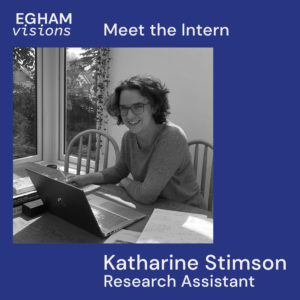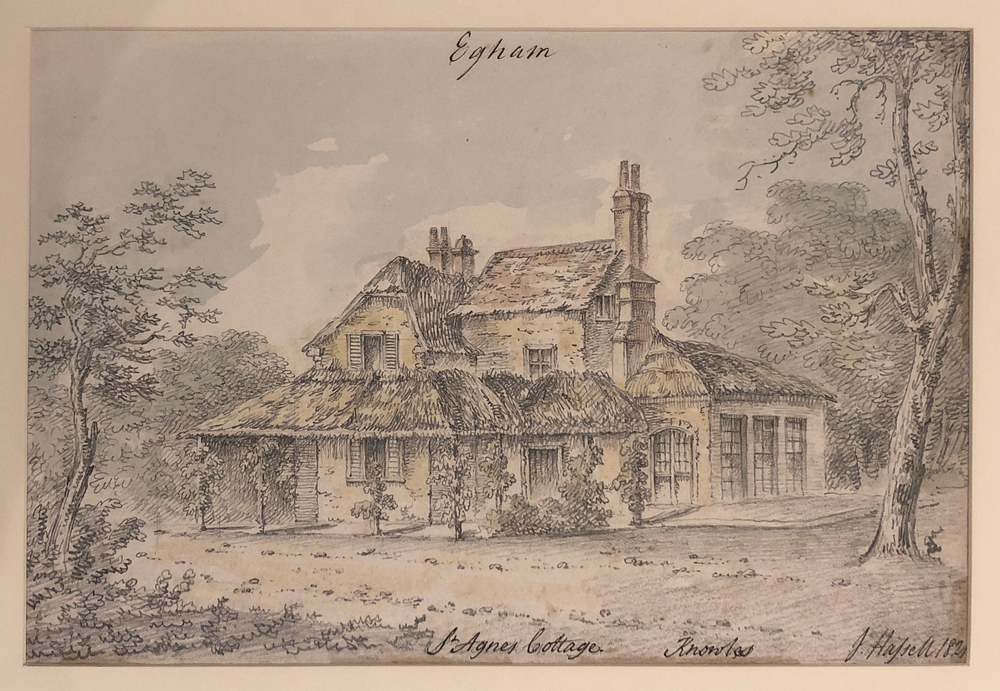
Katharine Stimson interviewed by artist Estella Castle
What attracted you to the role as the research assistant to the Egham Visions project?
The period the Hassell paintings are from was what attracted me first as I’m particularly interested in the early nineteenth century, but also I love the process of research – the treasure hunt feeling of digging through lots of information for the nugget of gold appeals to me in a really geeky way.
How does researching for an artist residency programme differ from your past experiences?
Not really knowing what the ultimate outcome of the research will be is a bit of a different feeling to what I’m used to. Previously I’ve worked either on my own academic work or in the production of something, like an edited volume of letters or a museum provenance file, where there is a predefined outcome before you begin, even if your path changes a little as you go along. This is exciting because it is so broad and what turns up through the research will shape the final artistic production. The research will help bring something totally new to life in the modern day landscape of these paintings as well as throw a light on their past, so that’s different to anything I’ve done before.
What is your process when researching each of the locations and properties depicted in the Egham John Hassell collection?
It’s been a bit of a test having to do it all online and sometimes via some unusual channels. It’s a bit of an odd situation, due to Covid-19, not being able to access any primary sources unless you are lucky enough to find they’ve been digitised, and it’s forced me to find creative ways to double check facts. I usually start by searching broadly any property and people’s names either written on the painting or accession card just to give me some starting points. Then I dig deeper from there heading especially towards local and national archives for parish and land records, and online newspaper archives. Ancestry and Find My Past are also really useful resources. I’m finding the people who lived in the properties are the real key to building a picture of the place and once particular characters begin to emerge as important then I can get a bit more focused on their family history and flesh out any particularly interesting aspects of their worlds.
Have you been surprised or intrigued by any of the particular narratives or histories you have so far uncovered?
Coming from a background in Romantic literature I was excited to discover that the occupant of one of our houses (St Agnes Cottage) knew Percy Shelley and Thomas Love Peacock and was actually a writer herself. I’ve also found the stories of some of the merchants and self-made men quite intriguing, how they were able to reach the position of living in these houses alongside people with inherited wealth and titles. It’s interesting trying to imagine these various stories running alongside each other in the local community and to think about how they all interacted.

Egham Museum PR157
How have you found working during Covid-19? For example we have never met and you have only been able to visit the museum once.
It is strange to think we’ve never met! I feel like we have as we’ve been in touch through video calls. It’s frustrating not to be able to use the resources at the museum but it’s pushed me to really milk what is out there online. Being a bit of a natural hermit who likes hiding away in libraries, I haven’t found the isolated nature of the work too much of a problem. Working alongside homeschooling my two children has sometimes been tricky, but on the whole it’s worked well.
What advice would you have for individuals interested in researching their own local history?
I would say don’t be intimidated and just start with what you know and work from there. Your bubble of knowledge will grow quickly and it can be really addictive. Take lots of notes as you never know when a loose end will suddenly become useful. The various genealogical websites out there are an excellent way to start and you can find lots of basic information. Beyond that, local museums like Egham and archives like the Surrey History Centre will have experts who can help you dig a bit deeper. I think my main piece of advice would be to beware of taking anything at face value, always find a second source if you can, or another way to prove a connection. Be sceptical until you’re really sure, even if you desperately want to put that piece of the jigsaw in, in fact especially if you want to put it in!
